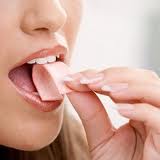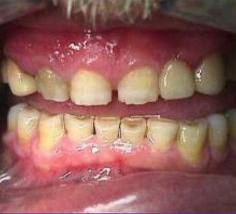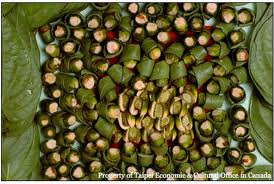1. Bruxism/clenching
Bruxism can be defined as the habitual grinding of teeth when a person is not swallowing or chewing, whether consciously or subconsciously. It usually occurs during sleep at night and is not detected by the person himself, but by the person sleeping next to the person. It is believed to be invoked by stress. Teeth clenching is more common during the day, and is associated with nervousness, stress, or a heightened state of emotion. These habits apply a heavy load onto the teeth over a long period of time causing the teeth to slowly wear down, decrease in height (attrition), and eventually exposing the dentine. Also, these habits have a heavy toll on the temporomandibular joint (TMJ), or the jaw joint, leading to temporomandibular disorders or pain.
2. Putting something between your teeth, e.g. pen, needle, pipe smoke
Putting something between your teeth (especially front teeth) and even chewing it over a long period of time can cause the teeth to crack or chip off. Sometimes it can also cause teeth to drift, leading to crooked teeth, which is an unpleasant sight if the front teeth are involved.
3. Bulimia nervosa
Bulimia nervosa is an eating disorder characterized by self-induced vomiting and binging or overeating. The person sticks a finger down the throat, inducing gagging followed by vomiting. As a result, the gastric acids that are secreted to break down food is expelled along with the swallowed food. These acids are harmful to teeth as they can cause erosion of tooth surfaces. The surfaces of teeth facing the throat are the most prone to such erosion, and a dentist can detect a bulimic patient from this pattern of teeth erosion.
4. Smoking
Smoking is evidently harmful for teeth as they cause staining of teeth, increase in calculus formation and gum diseases, and can even lead to oral cancer.
5. Betel leaf /areca nut
Chewing areca nut wrapped in betel leaf is a common habit among many Asian and Oceanic countries including Sri Lanka, Taiwan, Cambodia, Thailand, Pakistan, Bangladesh, etc. This habit causes staining of teeth and mucosa, and sometimes even cause cancerous lesions.
6. Habits such as thumbsucking, lip/cheek/nail biting
Habits such as thumbsucking, lip or cheek biting, and nail biting can lead to malalignment of teeth, especially if the habit is cultivated from a young age. Nail biting is usually associated with anxiety. Not only can it cause cracking or chipping of your teeth, fingernails are particularly prone to dirt and germs which can be easily transferred into the mouth through nail-biting.
7. Chewing ice
Some people have the habit of chewing the remaining ice after a glass of drink. This can cause teeth to crack due to the hardness and coldness of the ice.
8. Chewing lemon, white wine, fruit juices
Lemon contains citric acid which, if in contact with tooth surface for a long period of time as in chewing lemon, causes erosion of the tooth surface as in bulimia. Some people consume white wine instead of red wine for the fear of teeth-staining. However, white wine is acidic, which also leads to erosion of tooth surface. Fruit juices contain more harmful sugar than the fruit itself because during the juicing process, some of the sugar is broken down into smaller, more caries-inducing sugar. This can be likened to eating bread, which is primarily made up of carbohydrate. Left in the mouth over a period of time, the enzymes in saliva breaks the carbohydrate into glucose, which is sugar (hence why it will taste sweet in your mouth). Drinking fruit juices will have similar caries risk as does drinking sugary carbonated drinks.
9. Sugary drinks
As is well-documented, sugary drinks like carbonated drinks and coffee and tea served with sugar are harmful for teeth. Drinking them straight from cans or a bottle is a further hazard because all the dentition is exposed to the drink. Drinking from a straw can decrease this hazard. For better dental health, you can also opt for tea and coffee without adding sugar, or adding artificial sweeteners. You can also substitute the regular carbonated drinks, with one such as diet coke or pepsi light, which also uses artificial sweeteners.
10. Brushing too hard
Overzealous brushing and wrong technique of tooth-brushing (horizontal direction) can lead to gradual loss of tooth substance, especially at the neck of the tooth. This phenomenon is known as “cervical abrasionâ€.
 11. Excessive chewing gum
11. Excessive chewing gum
Chewing gum can be harmful to teeth because it is likened to chewing sweet for a much longer time. Those who like to chew gum should go for those with artificial sweeteners. In fact, chewing non-sugary gum can help prevent caries by stimulating production of saliva, which has a protective effect on teeth. However, too much of one thing is never good. Excessive gum chewing can lead to TMJ problems due to excess load on the joint.

